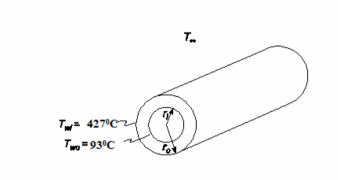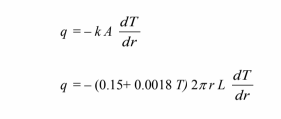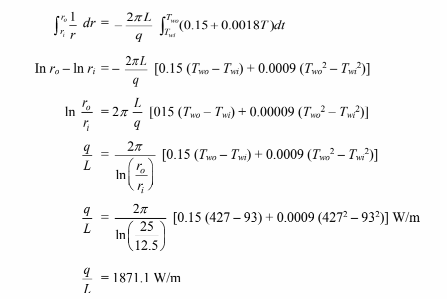A long, hollow cylinder is constructed from a material whose thermal conductivity is a function of temperature according to k = 0.15 + 0.0018 T, where T is in C and k is in W/(m K). The inner and outer radii of the cylinder are 12.5 and 25 cm, respectively. Under steady-state conditions, the temperature at the interior surface of the cylinder is 427°C and the temperature at the exterior surface is 93°C. (a) Calculate the rate of heat transfer per meter length, taking into account the variation in thermal conductivity with temperature. (b) If the heat transfer coefficient on the exterior surface of the cylinder is 17 W/(m2 K), calculate the temperature of the air on the outside of the cylinder.
GIVEN
• A long hollow cylinder
• Thermal conductivity (k) = 0.15+ 0.0018 T [T in °C, k in W/(m K)]
• Inner radius (ri) = 12.5 cm
• Outer radius (ro) = 25 cm
• Interior surface temperature (Twi) = 427°C
• Exterior surface temperature (Two) = 93°C
• Exterior heat transfer coefficient ( oh ) = 17 W/(m2 K)
• Steady-state conditions
FIND
(a) The rate of heat transfer per meter length (q/L) (b) The temperature of the air on the outside (T?) ASSUMPTIONS
• Steady state heat transfer
• Conduction occurs in the radial direction only
SKETCH

(a) The rate of radial conduction is given


Integrating this from the inside radius to the outside radius

(b) The conduction though the hollow cylinder must equal the convection from the outer surface in steady state

Solving for the air temperature

You might also like to view...
The person who first explained the discrete hydrogen atom spectrum was __________
Fill in the blank(s) with correct word
A radioactive atom has 98 protons and 249 nucleons. If it undergoes alpha decay, what are the number of protons and nucleons, respectively, in the daughter nucleus?
A) 100, 249 B) 100, 245 C) 96, 245 D) 96, 247 E) 94, 247
If Earth's mass somehow decreased with no change in its radius, your weight would
A) decrease also. B) increase. C) remain the same.
Which of the following is a unit of mass density?
a. kg/m3 b. g/cm2 c. lb/ft3 d. lb/ft2